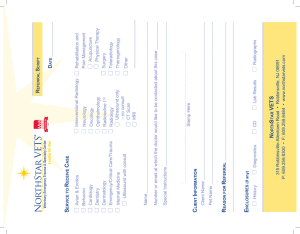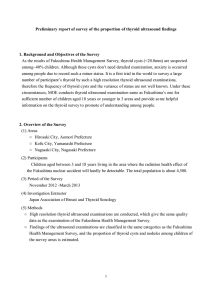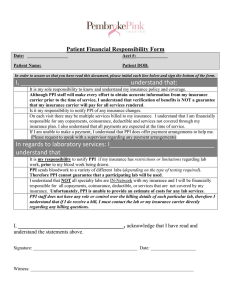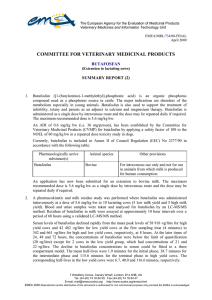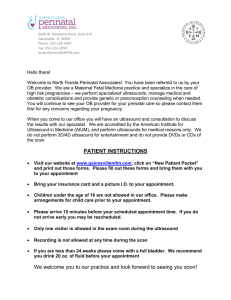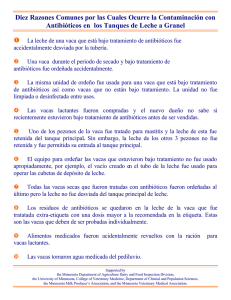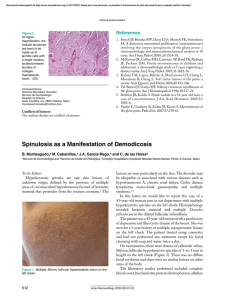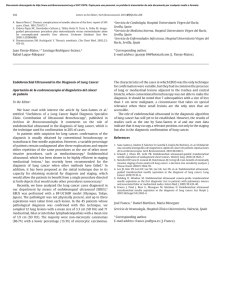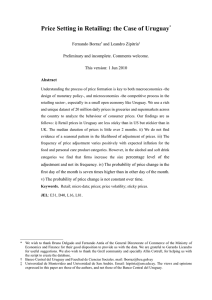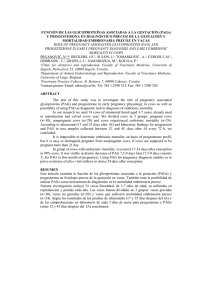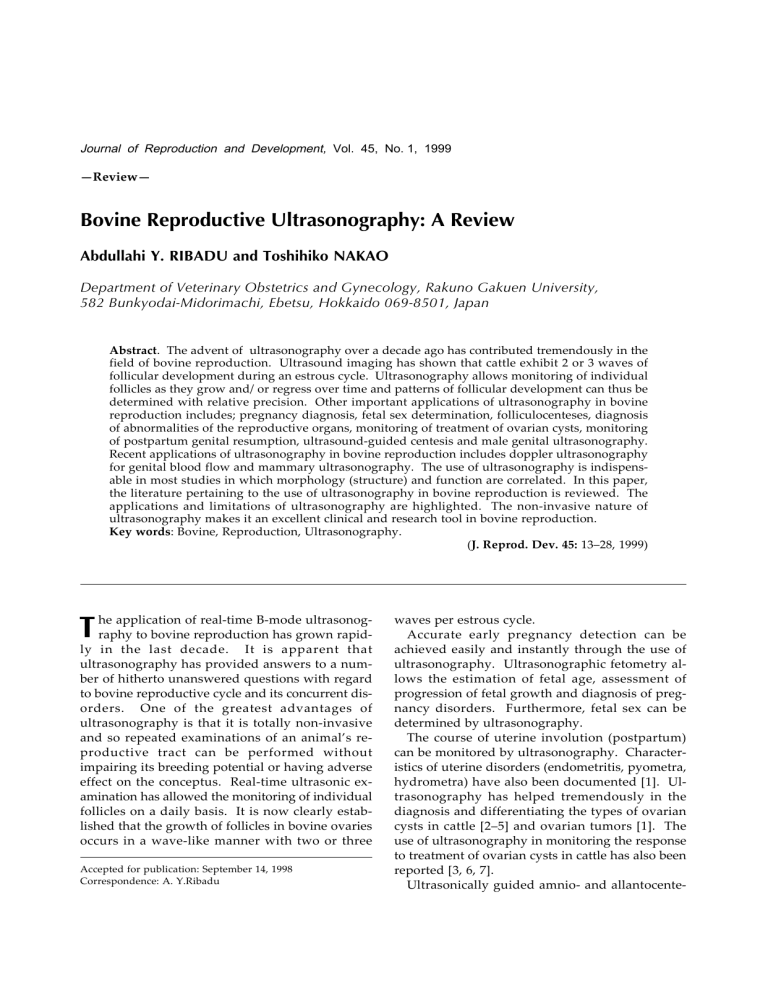
Journal of Reproduction and Development, Vol. 45, No. 1, 1999 —Review— Bovine Reproductive Ultrasonography: A Review Abdullahi Y. RIBADU and Toshihiko NAKAO Department of Veterinary Obstetrics and Gynecology, Rakuno Gakuen University, 582 Bunkyodai-Midorimachi, Ebetsu, Hokkaido 069-8501, Japan Abstract. The advent of ultrasonography over a decade ago has contributed tremendously in the field of bovine reproduction. Ultrasound imaging has shown that cattle exhibit 2 or 3 waves of follicular development during an estrous cycle. Ultrasonography allows monitoring of individual follicles as they grow and/or regress over time and patterns of follicular development can thus be determined with relative precision. Other important applications of ultrasonography in bovine reproduction includes; pregnancy diagnosis, fetal sex determination, folliculocenteses, diagnosis of abnormalities of the reproductive organs, monitoring of treatment of ovarian cysts, monitoring of postpartum genital resumption, ultrasound-guided centesis and male genital ultrasonography. Recent applications of ultrasonography in bovine reproduction includes doppler ultrasonography for genital blood flow and mammary ultrasonography. The use of ultrasonography is indispensable in most studies in which morphology (structure) and function are correlated. In this paper, the literature pertaining to the use of ultrasonography in bovine reproduction is reviewed. The applications and limitations of ultrasonography are highlighted. The non-invasive nature of ultrasonography makes it an excellent clinical and research tool in bovine reproduction. Key words: Bovine, Reproduction, Ultrasonography. (J. Reprod. Dev. 45: 13–28, 1999) he application of real-time B-mode ultrasonog- T raphy to bovine reproduction has grown rapidly in the last decade. It is apparent that ultrasonography has provided answers to a number of hitherto unanswered questions with regard to bovine reproductive cycle and its concurrent disorders. One of the greatest advantages of ultrasonography is that it is totally non-invasive and so repeated examinations of an animal’s reproductive tract can be performed without impairing its breeding potential or having adverse effect on the conceptus. Real-time ultrasonic examination has allowed the monitoring of individual follicles on a daily basis. It is now clearly established that the growth of follicles in bovine ovaries occurs in a wave-like manner with two or three Accepted for publication: September 14, 1998 Correspondence: A. Y.Ribadu waves per estrous cycle. Accurate early pregnancy detection can be achieved easily and instantly through the use of ultrasonography. Ultrasonographic fetometry allows the estimation of fetal age, assessment of progression of fetal growth and diagnosis of pregnancy disorders. Furthermore, fetal sex can be determined by ultrasonography. The course of uterine involution (postpartum) can be monitored by ultrasonography. Characteristics of uterine disorders (endometritis, pyometra, hydrometra) have also been documented [1]. Ultrasonography has helped tremendously in the diagnosis and differentiating the types of ovarian cysts in cattle [2–5] and ovarian tumors [1]. The use of ultrasonography in monitoring the response to treatment of ovarian cysts in cattle has also been reported [3, 6, 7]. Ultrasonically guided amnio- and allantocente- RIBADU and NAKAO 14 ses in pregnant cows [8] and ultrasound guided transvaginal folliculocentesis for in-vitro fertilization [9] and mammary ultrasonography [10, 11] are other important applications of ultrasonography. The use of ultrasonography to help predict observed oestrus in dairy cows after administration of prostaglandin has been reported recently [12]. Currently, there is scanty of information on the use of ultrasonography in bovine male reproduction. Ultrasonographic characteristics of bull testes and accessory sex glands have been reported [13–15]. The potential for the use of ultrasonography in bovine male reproduction is enormous. Although some review articles on bovine and large animal ultrasonography have appeared previously [16, 17], the need to have an up-to-date information on the rapidly growing field of bovine reproductive ultrasonography prompted this review. Principles of Ultrasonography Ultrasound is defined as any sound frequency above the the normal hearing range of the human ear; i.e. greater than 20,000 Hz [18]. Detailed reviews of basic principles of transrectal ultrasonography have been reported [18–21]. Briefly, ultrasonography utilizes high frequency sound waves to produce cross sectional images of the tissues and internal organs. The sound waves are produced by vibrations of specialized crystals (piezo-electrical crystals) housed in the ultrasound transducer. Vibrations of the crystals are produced by pulses of electric current. A proportion of sound waves reflected back to the transducer is converted to electric current and displayed as an echo on the ultrasound viewing screen. The transducer, therefore, acts as both the sender and receiver of echoes. The echoes are evident on the viewing screen as varying shades of gray (black to white). The absolute value of the acoustic impedance of any tissue is relatively unimportant, because it is the magnitude of the difference in acoustic impedance at tissue interface that determine the amount of reflection of the beam [18]. Most ultrasound scanners used in bovine reproduction currently are B-mode (brightness modality) real-time scanners. In B-mode ultrasonography, the image is a two-dimensional display of dots (pix- els), the brightness of the dots is proportional to the amplitude of the reflected echoes returning to the transducer. Real-time refers to the ability to image movements (e.g. fetal heart beat or motion) as it occurs. Dynamics of some reproductive structures or events (i.e. ovulation) could be studied by video tape recordings of real-time ultrasound examinations. Ultrasound scanners are equipped with transducers of varying frequencies. The most commonly used frequencies in bovine reproduction are 3.5, 5.0 and 7.5 MHz. The higher the frequency of the transmitted sound waves, the better the image resolution, but the shallower the depth of penetration [2, 18]. There are two types of scanners; linear array and sector. Linear array transducers have piezo-electric crystals arranged in rows and as such the image produced by linear array transducer appears rectangular. Sector transducers, on the other hand, have only a few such crystals and the image produced is pie-shaped corresponding to the field of scan. Mechanical sector scanners offer multifrequency capability in a variety of scan head design with 3.0, 5.0 and 7.5 MHz crystals in a single scan head. Because of the versatility of these machines, they are also more expensive than linear-array systems [22]. Recent ultrasound scanners have a wider frequency range and accept a full line of single and dual frequency probes. Digital image port for computer image storage is also available. Battery-powered portable ultrasound scanners are also currently available. Doppler ultrasonography which detects turbulence within blood vessels and direction of flow, is also a useful diagnostic tool in bovine reproduction. The Doppler phenomenon is the change in sound frequency of a moving object as perceived by a stationary observer. Doppler ultrasound machines detect frequency change and, therefore, movement which is converted to an audible signal [23]. The major considerations in selecting an ultrasound scanner are price, resolution quality, portability, serviceability and technical support [24]. Other factors include memory capabilities, remote control, transducer and cable design (I or T), single or dual frequency probe and above all, the use for which the machine would be put. For routine bovine reproductive ultrasonography (early pregnancy diagnosis, pathology of the ovaries and uterus, fetal sexing etc) a 5 MHz linear rectal BOVINE REPRODUCTIVE ULTRASONOGRAPHY transducer seem to be the most versatile and effective. However, a 7.5 MHz linear transducer is recommended for follicular dynamics studies. For transvaginal oocyte recoveries, a convex-linear transducer gives better results. Techniques For transrectal or transcutaneous ultrasound scanning in cattle, no sedation is indicated as the procedure is totally non-invasive and well tolerated. Adequate restraint is however required and the scanner should be placed at a sensible distance from the cow/bull on the side opposite the operator‘s rectalling arm. All precautions that apply to palpation per rectum are applicable to transrectal scanning. All feces from the rectum should be evacuated prior to introduction of the transducer. It is often advantageous to carry out a preliminary exploration of the topography of the reproductive tract before commencing the ultrasonographic examination. The transducer face is lubricated with a suitable coupling medium and is usually covered by a lubricated plastic sleeve before insertion in a cupped, lubricated hand through the anal opening. It is then progressed cranially along the rectal floor to overlie the reproductive tract. The transducer face must be pressed firmly against the rectal mucosa in order to effect ultrasound transmission through the rectal wall into abdominal viscera. The probe is moved across the reproductive tract in a thorough and systemic manner [23, 25]. Basal requirements To make an accurate diagnosis via an ultrasonographic examination, ambient lighting is imperative. A darkroom is ideal for viewing the monitor and helps the human eye recognize as many shades of gray as possible. When examinations are carried out in lighted conditions, some type of hood must be draped over the monitor to facilitate effective gray-shade delineation [24]. Interposition of any contaminating feces will prevent ultrasound transmission and produce poor imaging and artefactual interference. The ultrasound screen and the human eye should be at similar level for accurate interpretation of ultrasound images. Interpretation of ultrasound images Interpretation of ultrasonographs of the repro- 15 ductive tract require a thorough understanding of the composition of the images and an awareness of the possible artifacts which can occur and lead to a misdiagnosis. As sound waves pass through the tissues and surrounding areas they may be modified in a number of ways. Sound waves passing through body structures will encounter tissue interfaces and the returning echoes will be of varying strengths and so produce a variety of images. The ultrasonic characteristic of a tissue depends on its ability to reflect sound waves. Liquids do not reflect sound waves (i.e. are nonechogenic or anechoic) and are represented on the viewing screen as black. The ultrasonic images of liquidcontaining portions of structures such as ovarian follicles, embryonic vesicles appear black. Dense tissues (e.g. bone) reflect a large proportion of the transmitted sound waves (i.e. echogenic) and is represented on the viewing screen as light gray or white. Various tissues and contents of the reproductive tract appear on the screen in varying shades of gray depending upon their echogenicity [18]. Some common artifacts include; distant enhancement (occurs when the incident sound beam strikes the far wall of a fluid-filled structure; e.g follicle, embryonic vesicle), refraction artifacts, specular reflection, reverberation artifacts, acoustic shadowing [23]. A detailed review of imaging artifacts in diagnostic ultrasound has been published [26]. Ultrasonography of Normal Ovarian Structures Follicles The ultrasonographic anatomy of the ovaries of the cow has been described in detail [3, 27–29]. Antral follicles of various sizes appear as nonechogenic structures which could be distinguished from blood vessels in cross-section by the elongated appearance of the latter [29, 30]. There was a linear relationship between follicle diameter measured by in vivo ultrasonography and follicle diameter determined after slaughter [31]. Correlation coefficients of 0.7–0.9 for various sizes of follicular structures were recorded between in vivo ultrasonography and postmortem slicing of excised ovaries [31–35]. These studies showed that transrectal ultrasonography is a reliable method for identifying and measuring follicles in bovine ovaries. In a recent study on ultrasound echotex- 16 RIBADU and NAKAO ture of follicles and functional and endocrine status in 32 heifers [36], it was shown that the echotexture characteristics of the ultrasound images of the follicle antrum and wall (after ovariectomy) were correlated with the functional and endocrine status of a follicle. Mean pixel (picture element) values (grey scale: black=0; white=255) for the follicle wall and stroma increased progressively from the growing to regressing phases of the dominant follicle of the first follicular wave. Pixel heterogeneity of the antrum and wall were negatively correlated with estradiol and estradiol:progesterone ratio in follicular fluid. Ovarian ultrasonography has shown that the development of bovine follicles occurs in a distinct, striking regular pattern [37]. Each wave consists of the contemporaneous emergence of a group (cohort) of follicles 5 mm or more in diameter. Within several days, one follicle has grown larger than the cohort and is considered dominant [38–41]. Ultrasonography has revealed the existence of two [32, 42, 43] or three [40, 41] follicular waves per estrous cycle in heifers. Each dominant follicle has a growing phase and a static phase; each lasting for about 5–6 days. The dominant follicle of the first wave is anovulatory. It remains dominant for 4–5 days, and generally by day 11 or 12 of the estrous cycle, it loses its dominance and begins to regress which lasts for 5–7 days. In the meantime, the second wave of follicles has been recruited and selection of the second wave dominant follicle has occurred, this dominant follicle goes on to ovulate. In a three wave cycle, however, this second dominant follicle regresses, making way for yet another group of follicles, with the third dominant follicle ovulating [43, 44]. Analysis of follicular dynamics has shown that dominant non-ovulatory follicles remain as the largest follicle for several days after the start of the succeeding wave, which implied that a dominant follicle retains morphological dominance (largest follicle on a pair of ovaries) longer than it retains functional dominance (ability to suppress growth of other follicles) [45]. Ultrasonography has been used to study ovarian response to superovulation in cattle [46–49]. The influence of a dominant follicle on the superovulatory response has been reported in heifers and cows [50–53]. The presence of a dominant follicle seem to have a negative influence on superovulatory re- sponse. Thus, assessment of follicular status prior to initiation of a superovulatory treatment may be an important consideration. Guilbault et al. [54] have indicated that decreased superovulatory response and embryo recovery in FSH-primed heifers may be due to the presence of higher numbers of follicles 7–10 mm and >10 mm prior to the initiation of the superovulatory treatment which limited recruitment of follicles 2–3 mm during the superovulatory treatment. Follicular dynamics in heifers and cows during early pregnancy were investigated [55–57]. A wave-like pattern of growth and regression of large follicles was observed through the first 60–70 days of pregnancy in all the studies. It was concluded that the follicular dynamics during the first 60–70 days of pregnancy were similar to those during non pregnancy. Bergfelt et al. [58] have reported that the continued periodic emergence of anovulatory follicular waves in pregnant heifers was associated with continued production of progesterone as evidenced by the continued periodic emergence of waves in non-bred progesteronetreated heifers. Ovulation Determination of ovulation by ultrasound examination was reported by Larrson [59]. The ovaries of 8 heifers were examined by ultrasonography every 4th hour during and after estrus. Ovulation was depicted by the absence of a preovulatory follicle that was present at a previous examination and subsequently confirmed by the development of corpus luteum at the same spot. The usefulness of ultrasonography performed at 2-hourly intervals for detecting the onset of ovulation was also demonstrated [60]. Corpora lutea The ultrasonic characteristics of corpora lutea (CL) has been described [5, 28, 29, 61]. Generally, a CL is identified ultrasonically from 3 days after ovulation. A developing CL appears on the ultrasound image as a poorly defined, irregular, greyish-black structure with echogenic spots all within the ovary; a mid-cycle CL is a well defined granular, greyish echogenic structure with a demarcation line visible between it and the ovarian stroma; in a regressing CL the demarcation line is faint, owing to the slight difference in echogenicity between the tissues [33]. Corpora lutea with BOVINE REPRODUCTIVE ULTRASONOGRAPHY cavities appear as a centrally located nonechogenic area surrounded by greyish echogenic luteal structure. The size and shape of the cavities varies according to the cyclic stages of the CL [2, 62, 63]. The presence or size of central fluid-filled cavity affected neither the plasma progesterone secretion nor subsequent reproductive performance [34]. These structures represent a normal variation of CL in bovine. Kähn and Ludlow [64] compared palpation per rectum and transrectal ultrasonography (with a 5 MHz transducer) with ovarian dissection for identifying mid-cycle CL and obtained a sensitivity of 85% for both methods. Complete agreement was reported between in-vivo ultrasonography and postmortem slicing of ovaries for identification of CL and the presence of CL with cavities [61]. Pieterse et al. [33] reported that the sensitivity and predictive value of palpation for detecting mid-cycle CL were 83.3% and 73.2% and those of transvaginal ultrasonography (with a 5 MHz transducer) were 80.6% and 85.3%, respectively. In another study, Ribadu et al. [5] compared the evaluation of midcycle CL by palpation per rectum, ultrasonography (with 7.5 MHz transducer) and plasma progesterone concentration and obtained a sensitivity, specificity and positive predictive value of palpation as 85%, 95.7% and 89.7%, respectively. Ultrasonography had a sensitivity of 95%, a specificity of 100% and a positive predictive value of 100%. Quirk et al. [65] stated that decreases in the size of the CL in heifers coincided with decreases in the plasma concentrations of progesterone. Sprecher et al. [66] obtained a correlation coefficient of 0.68 between milk progesterone measured by radioimmunoassay and luteal diameter measured by ultrasonography. Song-Chang et al. [67] also reported a significant correlation between CL size (as determined by ultrasonography) and milk progesterone concentration in 16 dairy cows. Kastelic et al. [68] concluded that an ultrasonographic assessment of CL was a viable alternative to measurement of plasma progesterone concentration for the evaluation of luteal function. It should be noted however, that even though a high correlation exists between the CL diameter measured by ultrasound and plasma progesterone concentration during most days of the estrous cycle; the correlation was absent during the last few days of the estrous cycle when sharp decline of progesterone 17 concentration was not accompanied by a commensurate decrease in CL size as visualized by ultrasonography [5, 69]. A similar trend was observed by Kamimura et al. [34] who reported that the estimated volume of corpus luteum (by ultrasonography) and plasma progesterone concentration in early postpartum cows increased with similar profiles during the luteal growth but decreased more slowly than the fall in plasma progesterone level during luteal regression. Ultrasonography of the Uterus during the Estrous Cycle The ultrasonic anatomy of the uterine horn has been described [29, 32]. The ultrasound image of the uterus showed a distinctly echogenic structure with different layers of the uterine horn reflected by differing echotextures. The echotexture of the endometrium was characterized by the presence of non-specular reflections with dark and bright signals seen within the ultrasound image of the endometrium. The changes in the morphology of the uterus during the estrous cycle has been characterized ultrasonically in 22 Holstein heifers monitored during 58 interovulatory intervals [70]. The ultrasonographic appearance of the uterus was influenced by the stage of the estrous cycle. Uterine echotexture was characteristically dark during the follicular phase (estrus) reflecting an extensive degree of edema of the endometrium. The uterine horns were maximally curled during luteal dominance but were less curled during follicular dominance. Ultrasonographic Detection of Pregnancy The early and accurate diagnosis of pregnancy in cattle is essential for the maintenance of high levels of reproductive efficiency. Chaffaux et al. [71] first reported the use of real-time ultrasonography to diagnose pregnancy in cattle. Using a 3.5 MHz transducer, they observed irregularly shaped nonechogenic structures in the lumen of the uterus from day 28 post-insemination. Later, several authors [72–81] reported on the use of ultrasonography to diagnose pregnancy in cattle. Pierson and Ginther [72] using a 5 MHz transducer, reported the presence of discrete 18 RIBADU and NAKAO nonechogenic areas within the uterus at days 12 and 14. The changes in the ultrasonographic appearance of the bovine conceptus from time of first detection of the embryo proper (day 20) to day 60 of pregnancy was reported [75]. The embryo was seen initially as a small echogenic line on day 20. By days 22 to 30, the embryo had a prominent Cshape. Boyd et al. [82], using a 7.5 MHz transducer in 22 Friesian dairy cows reported that the conceptus was tentatively observed at day 13 within the vesicle. The vesicle suddenly enlarged at day 19 and the heart beat was detected in the embryo at day 22. Tentative early pregnancy diagnosis (before detection of an embryo proper) was based on the finding of discrete, nonechogenic structure or line within the uterine lumen but must be subsequently confirmed by the progressive elongation of the nonechogenic area and eventual detection of embryo proper. Definitive diagnosis was unreliable before day 18 using a 5 MHz transducer [83] and before day 16 using a 7.5 MHz transducer [84]. A wide variation in the levels of accuracy for pregnancy diagnosis (70–100%) has been reported by several authors [76, 77, 83, 85–88]. The level of accuracy depends on factors like; the type of ultrasound equipment used (sector or linear), transducer frequency (3.5, 5.0 or 7.5 MHz), stage of gestation and the experience of the operator. Generally, a 5 MHz or 7.5 MHz transducer tends to provide more reliable results than does a 3.0 MHz transducer for early pregnancy diagnosis. However, the reliable period of for pregnancy diagnosis with a positive predictive value of over 95% varies between days 20 and 42 postbreeding [17]. The use of ultrasonography for pregnancy diagnosis has no detrimental effect on either the dam or the fetus. In a recent study, Baxter and Ward [80] showed that the use of ultrasound scanners for early pregnancy diagnosis (at 30 to 40 days of gestation) did not increase the rate of fetal loss. The advantages of using ultrasonography for pregnancy diagnosis are that the presence of an embryo can be detected earlier than by palpation per rectum and that direct physical manipulation of the gravid reproductive tract is unnecessary with ultrasonography. Thus, the risk of inducing embryonic mortality is greatly reduced [89]. Fetal Sex Determination by Ultrasonography Fetal sex determination has several implications in the animal breeding industry. The gender of fetuses can be detected by visualization of the location of the genital tubercle [90] or the scrotum and mammary glands [91]. The most appropriate time of ultrasonographic sex determination is 55 to 60 days of gestation and the technique can be accurate even under farm conditions [92]. In another study, Viana and Marx [93] used ultrasonography to determine the sex of bovine fetuses between 60th -90th day of pregnancy in 716 embryo recipient cows and heifers. Verification tests on calves born revealed a correct diagnosis of 96.3%. It was concluded that this technique offers a new tool for the management of cattle industry. It should be emphasized however, that ultrasonic identification of the genital tubercle or the scrotum and mammary glands for sexing purposes requires considerable experience. Ultrasonographic Fetometry Although a cow’s calving date can be predicted with reasonable precision from a knowledge of service date (whether AI or supervised natural mating), it is however difficult when cows are run together with a bull, mating is frequently not observed and the dates of service may be unknown. Accurate estimate of calving dates could be a good management tool as cows can be rationed more precisely in late pregnancy to achieve the appropriate level of body condition at calving [94]. Management at calving could also be eased if cows could be grouped according to their expected calving dates. Estimation of fetal age, monitoring of fetal growth across time and diagnosis of pregnancy disorders can be performed by ultrasonographic fetometry. Growth curves of fetal structures based on ultrasonographic fetometry have been reported [95, 96]. Kähn [96] described in detail the sonographic fetometry of fetuses in 19 pregnant heifers. A total of 485 examinations were carried out between 2 to 10 months of pregnancy. The organs evaluated included eyeball, brain case, stomach, trunk, ribs, metacarpal diaphysis, os ilium and os ischii, scrotum and umbilical cord. For determina- BOVINE REPRODUCTIVE ULTRASONOGRAPHY tion of the size of organs, the transducer was manipulated so that the largest sonographic section of the structure was obtained on the screen. Regression and correlation coefficients of fetal structures were calculated depending on days of gestation. It was concluded that intra-uterine development of the bovine fetus and its gestational age may be judged from the size of its organs and parts of the body. Ultrasonographic fetometry has been shown to provide a precise estimation of gestational age and prediction of calving dates [94]. In a study of 300 pregnant beef cows between 35 and 125 days of gestation, Wright et al. [94] reported the mean difference between the actual and predicted calving dates as 0.9 ± 9.0 S.D (days). It was concluded that the accuracy and precision of the prediction of calving date were sufficient to be of benefit in the management of cows in late pregnancy and at calving. 19 by day 28–40 postpartum based on ultrasonographic assessment. The difference in the mean day of completion of uterine involution may be attributed to differences in sample sizes, parity and level of management. Ultrasonographic evaluation of uterine involution in 11 Swedish cows with retained fetal membranes [99] revealed accumulation of snowy fluid and thickening of the endometrium and uterine walls in all cows. In a recent study, Torres et al. [100] monitored uterine involution in 33 dairy cows and reported that uterine involution was completed at 4 weeks postpartum in cows with normal puerperium (n=12) but was delayed in 23.8% of cows with abnormal puerperium (n=21). These studies have demonstrated that ultrasonography is a useful tool in monitoring the progress and completion of uterine involution. Ultrasonographic Diagnosis of Ovarian and Uterine Abnormalities Ultrasonography of Postpartum Uterus Serial ultrasonographic assessment of bovine postpartum uterine involution has shown that total uterine diameter and endometrial thickness decreased over time to reach a static size at completion of uterine involution. Ultrasonographic evaluation of the diameter and shape of the postpartum uterus, echotexture and layers of the uterine wall and intraluminal fluid accumulation has been reported in cows [97]. Uterine involution was completed at approximately 40 days based on ultrasonic assessment of uterine horn diameters. Kamimura et al. [ 34] also monitored the progress of uterine involution by twice-weekly ultrasonography in 40 Holstein cows and reported completion of uterine involution by 41.5 days postpartum. Uterine involution in 15 Charolais cows were monitored by Santos et al. [98] using an ultrasound scanner at 3 day intervals from 8 to 40 days after calving. For cows with a normal parturition, uterine involution was completed an average of 28.12 ± 55 days after calving vs 32.75 ± 1.13 days for cows with dystocia. There were highly significant differences between cows with dystocia and those calving normally in the time taken for involution of the uterine horns. Taking the above studies together, uterine involution seem to be completed Ovarian cysts Ovarian cysts is an important cause of infertility in cattle. It is characterized by the presence of one or more follicular structures larger than 25 mm in diameter for 10 or more days in the absence of a corpus luteum [101]. Ovarian cysts are either follicular (thin-walled) or luteal (thick-walled). The difficulties of differentiating accurately between follicular and luteal cysts by palpation per rectum is well documented [102–106]. It is pertinent to distinguish follicular cysts from luteal cysts accurately as the approach to treatment may differ depending on the diagnosis. Ultrasonography provides a method of accurately differentiating the types of cysts. The ultrasound appearance of follicular and luteal cysts have been documented [1, 3–5, 107–110]. By ultrasonography, a follicular cyst appeared as a uniformly nonechogenic ovarian structure >25 mm in diameter with a wall <3 mm thick. Luteal cysts, on the other hand, appeared as nonechogenic structure >25 mm in diameter with grey patches within the antrum or along the inner cyst wall and a wall thickness >3 mm. It is necessary to distinguish luteal cysts from cystic corpus luteum as the latter is not pathological. For clear differentiation between the two, various criteria must be considered which include; overall size, shape of the cavity, thickness of the luteinized wall 20 RIBADU and NAKAO and echogenicity of the interior area. Cystic corpora lutea are usually no larger than 3 cm in diameter and the wall is about 5–10 mm thick. Corpora lutea are rarely spherical usually presenting an oval shape on the screen. The image of the cavities depend on direction of the ultrasound beam and is either circular or oval. The fluidfilled cavities of CL only seldom present reflections more often being homogeneous and near-black, whereas reflections are frequently observed in luteal cysts [1, 5]. Ultrasonography has proved to be useful in monitoring the dynamics of experimental ovarian cyst formation following the administration of steroids in heifers and cows [111–114]. Cyst turnover in spontaneous occurring ovarian cysts in cows [115] was also monitored. The ultrasound appearance of ovarian tumor have been reported [1, 116]. A compact, highly echogenic image interrupted by nonechogenic blood vessels was observed in a cow with granulosa cell tumor [1]. Ovarian cysts after treatment Prior to the introduction of ultrasonography, assessment of luteinization of follicular cysts following therapy was performed by palpation per rectum. However, incorrect assessment of luteinization of follicular cysts by palpation per rectum after treatment has been a problem [117, 118]. Ultrasonography is an effective tool for monitoring the response of cystic ovaries to therapy. Edmondson et al. [3] first reported the use of ultrasound to monitor the response of cystic ovaries following treatment. In a cow treated with gonadotropic releasing hormone, the cyst wall increased in thickness from 2 mm to 6 mm over a two week period. In a study on the use of ultrasound and progesterone profile to monitor the response of ovarian follicular cysts in 5 cows treated with gonadotropic releasing hormone, Ribadu et al. [6] have observed ultrasound changes after treatment which included; clouding of the uniformly nonechogenic antrum of cysts, luteinization of cysts wall, reduction in cyst size (resolution) and/or development of 1–4 corpora lutea on the ovary bearing the cyst or on the contralateral ovary. Multiple ovulation occasionally occur following GnRH therapy of ovarian follicular cysts. Treatment of cows with ovarian cysts (follicular or luteal) with progesterone releasing intravaginal device (PRID) or gonadotropic releasing hormone (GnRH) did not seem to have any immediate effect on either follicular or luteal cysts, but consistently resulted in estrus and ovulation; with subsequent CL formation as monitored by ultrasonography. Treatment of luteal cysts with prostaglandin caused marked decreases in cyst size with rough echotexture of the luteinized rim of the cyst within 2–4 days and the formation of new CL within 1 week after treatment [7]. Ohnami et al. [119] also monitored the response of ovarian cysts in 9 cows treated with GnRH analogue. Ultrasonography detected doughnut-like luteal structures after treatment which would not have been detected by palpation per rectum alone. Subsequent hormone measurement confirmed the luteal structures were fully functional. Jou et al. [120] monitored the ovarian response in cows with follicular cysts treated with GnRH followed by prostaglandin 10–12 days later (n=15) and saline followed by prostaglandin 10–12 days later (control; n=17) and reported no significant difference in the time from treatment to detection of the first CL or cyst disappearance in the 2 groups. Although the success rates following GnRH therapy of ovarian cysts varied amongst the various studies quoted above, the visualization by ultrasonography of cyst luteinization and, or the presence of CL in cows after treatment showed that in responding cases evidence of therapeutic success could be confirmed quickly [6]. Ultrasonography is thus, a useful tool for monitoring the response of ovarian cysts to treatment. Uterine abnormalities The usefulness of ultrasonography in diagnosing pathological conditions of the uterus has been reported [1, 121]. Uterine abnormalities recognised during ultrasonography included endometritis, pyometra, fetal maceration and fetal mummification. Ultrasonographic appearance of inflammatory conditions of the uterus were characterized by distended lumen filled to varying degrees with partially echogenic, diffuse, flaky reflections. The degree of echogenicity depended on the consistency of the fluid. When the uterine content was very thick and full of leucocytes and tissue debris; the echogenicity resembled that of uterine wall [1]. In fetal maceration, the fetal bones were identified as echogenic structures in the uterine lumen suspend- BOVINE REPRODUCTIVE ULTRASONOGRAPHY ed in nonechogenic fetal fluids with a thickened uterine wall. Fetal mummification, on the other hand, appeared as poorly defined mass (fetal mummy) with complete absence of uterine fluids. These studies have indicated that, ultrasonography is an effective tool for diagnosing and studying uterine abnormalities in cows. Although the use of ultrasonography in diagnosis of hydrometra in sheep and goats have been fairly documented [122–125], there is scanty information on its application in bovine. Ultrasonography may be helpful in diagnosis of hydrometra and mucometra in cattle. Ultrasonographic Folliculocentesis Ultrasound-guided transvaginal oocyte aspiration is helpful in obtaining ova from clinically infertile, but valuable cows for in-vitro fertilization. In this way, the genetic potential of such donor cows could be propagated. Pieterse et al. [9] described a technique for the repeated collection of bovine oocytes using transvaginal ultrasound guided aspiration during the normal estrous cycle and after stimulation with PMSG in 10 cows. A total of 36 transvaginal procedures were performed during which 54 oocytes were recovered from 197 follicles. Moyo and Dobson [126] using a 7.5 MHz linear array ultrasound transducer collected oocytes from 5 cows superovulated with ovine follicle stimulating hormone (oFSH). From 124 follicles punctured, oocyte recovery rate of 48% was recorded. In another study [127], an oocyte recovery rate of 50–70% has been reported in cows. In a study on the development of oocytes derived from the first dominant follicles of beef cows, Otoi et al. [128] monitored follicle development in 26 Japanese black beef cows by daily ultrasonography from day of estrus (day 0) until the first dominant follicle was aspirated. It was observed that the percentage of oocytes from first dominant follicles that developed to blastocysts tended to decrease with increasing follicular diameter and estrous cycle days. Also, recovery of oocytes by transvaginal ultrasound-guided follicle aspiration once or twice a week for up to 12 weeks in heifers did not affect subsequent response to superovulation and embryo recovery or the occurrence of estrus[129]. Ooe et al. [130] showed that ultra- 21 sound-guided transvaginal oocyte aspiration can be performed repeatedly and safely at different phases of the estrous cycle and stages of gestation in pregnant cows. In addition to collection of oocytes for in vitro fertilization, ultrasound guided folliculocentesis also allows the collection of follicular fluid for hormonal studies [131]. Ultrasound Guided Amnio- and Allantocentesis Amniocentesis is the collection of fetal amniotic fluid. The interactions between the fetus and the dam may be studied through the technique of amnio and allantocentesis. Specific objectives of amniocentesis includes; correlation of changes in biochemical constituents with gestational age, early determination of fetal sex by cytological analysis and as a source of fetal cells for the determination of prenatal transgenesis. Transvaginal ultrasound guided amnio and allantocentesis has been reported in 7 Dutch Friesian cows [8]. The pregnant uterus was rectally positioned against the puncture needle which was mounted on the intravaginally inserted ultrasound transducer (sector). It was shown that amniotic and allantoic fluid could be obtained in most ultrasound guided attempts and one fetus was carried to term even after repeated (weekly) amnio and allantocenteses. The risks of fetal deaths resulting from repeated punctures of the pregnant uterus (due to excessive manipulation and bacterial contamination) in a large percentage of animals limits the application of this procedure in routine pregnancy evaluation. However, collection of fetal amniotic fluid using ultrasound-guided transvaginal technique seem to be promising. In a recent study, Garcia and Salaheddine [132] have described the technical aspects of a safe and reliable ultrasound-guided transvaginal method of amniotic fluid collection from heifers (n=93) with day 79 to 90 bovine conceptuses using a very fine aspiration needle. Collection of amniotic fluid samples was successful in 88 out of 93 (94.6%) attempts, and no complications of pregnancy losses were recorded as consequence of the procedure. RIBADU and NAKAO 22 Mammary Ultrasonography Ultrasonography has important applications in the bovine mammary glands. Ultrasound studies have characterized not only the normal ultrasonographic appearance of the mammary glands and teats but also some pathologic lesions of the mammary glands. Cartee et al. [10] examined the udders and teats of 4 cows (in-vitro in a water bath) and 3 live cows and found no difference in the ultrasonographic appearance of the mammary glands. Teats appeared as hypoechoic structures with anechoic lumens while the papillary ducts appeared as a thin anechoic area within folds of the inner teat layer. Ultrasonography detected the presence of a hypoechoic mass in a cow that was examined because of obstructed milk flow from a quarter. In a further study [11], ultrasonic tomography was applied to evaluate the teat morphology and its use in preventing bovine mastitis. Ultrasonography of the Male Reproductive System The establishment of normal ultrasonic parameters for testicular dimensions and characterization of normal ultrasonic appearance are necessary to allow studies on degenerative and pathological conditions of the bovine testicle. Transcutaneous ultrasonic imaging has been used to characterize the ultrasonic morphology of the testicles of the bull [13, 14]. The normal bull testicle was reported as being homogeneous and moderately echogenic. The head and tail of the epididymis were easily identified on all testes, but the epididymal body and ductus (vas) deferens were difficult to identify. Ultrasonic measurement of testicles was correlated with testicular circumference, weight and volume but not with scrotal circumference [133]. Ultrasonic scanning of the bovine testicle was found to have no detrimental effect on reproductive capacity (semen characteristics, testicular dimensions and consistency) after exposure to a 3min scan with a 5.0 MHz transducer [134]. Recently, Bailey et al. [135] compared the reliability of caliper and ultrasonographic measurements of testicular length and width invivo in 10 bulls. The data demonstrated the reliability of using caliper and ultrasonographic imaging for measurements of testicular length and width. However, calipers were easier to use and demonstrated a higher degree of accuracy for measurement of testicular length. It was concluded that ultrasonography offers no added advantage over that of calipers for measuring the length of the in-vivo testicles except when only a width measurement is desired. The ultrasonic anatomy of the accessory sex glands of the bull has been described [15]. Transrectal ultrasonography was used to measure the vesicular glands, ampullae and bulbourethral glands. Ultrasonic measurements were found to be repeatable in individual bulls over time and it was concluded that the anatomic relationships and organ dimensions were accurately imaged by ultrasonography. Ultrasonography revealed testicular lesions in 95 bulls following in vitro injection of testes with crystalline, metallic or aqueous solutions [136]. Mickelson et al. [137] described the characteristic ultrasonographic changes in a bull with seminal vesiculitis. The changes observed included; increased glandular size, loss of normal lobular structure, increased glandular volume and the presence of bright fibrous tissue within the hyperechoic glandular parenchyma. Anderson et al. [138] used doppler ultrasonography and positive contrast cavernosography to evaluate a persistent penile hematoma in a bull. A wide scope exists for the use of ultrasonography in male reproduction. Conclusions The use of ultrasonography has allowed accurate monitoring of ovarian follicular development in heifers and postpartum cows on a daily basis in a non-invasive manner. This has contributed immensely to the understanding of follicular dynamics during the estrous cycle, early gestation and the postpartum period. In the areas of pregnancy diagnosis, fetal sex determination, folliculocenteses, amnio and allantocentesis, reproductive tract pathology, monitoring of normal and abnormal postpartum interval, diagnosis and evaluation of treatment of ovarian cysts, mammary ultrasonography, male reproduction; ultrasonography has proved to be a useful clinical and research tool. Ultrasonography is quite helpful for BOVINE REPRODUCTIVE ULTRASONOGRAPHY individuals who are inexperienced in palpation per rectum as palpation skills are acquired quickly while at the same time making accurate diagnosis via ultrasonography. One of the greatest constraints limiting the widespread use of ultrasonography in bovine reproduction is the high cost of the ultrasound machine. It is hoped that with the availability of several types of scanners (from different manufacturers) and improvements in the quality of scanners, the price may be affordable to a large number of veterinarians and research scientists and this will enhance its application in clinical as well as research studies of bovine reproduction. It must be emphasized that the use of ultrasonog- 23 raphy requires some skills. Such skills are usually obtained during university training or through attendance at continuous professional development (CPD) courses organized for such purposes. Furthermore, experience can be gained through the use of the ultrasound scanner repeatedly. Acknowledgements The authors wish to express their appreciation to Japan Society for the Promotion of Science (JSPS) for the award of a Postdoctoral Fellowship (for foreign researchers) to A.Y. Ribadu. References 1. Kahn W, Ludlow W. Characteristics of pathological conditions of the bovine uterus and ovaries. In: Taverne MM, Willemse AH (eds.), Diagnostic Ultrasound and Animal Reproduction. Kluwer Academic Publishers Dordrecht; 1989; 53–65. 2. Reeves JJ, Rantanen NW, Hauser M. Transrectal real-time ultrasound scanning of the cow reproductive tract. Theriogenology 1984; 21: 485–494. 3. Edmondson AJ, Fissore RA, Pashen RL, Bondurant RH. The use of ultrasonography for the study of the bovine reproductive tract I. Normal and pathological ovarian structures. Anim Reprod Sci 1986; 12: 157–165. 4. Farin PW, Youngquist RS, Parfet JR, Gaverick HA. Diagnosis of luteal and follicular ovarian cysts in dairy cows by sector scan ultrasonography. Theriogenology 1990; 34: 633–642. 5. Ribadu AY, Ward WR, Dobson H. Comparative evaluation of ovarian structures in cattle by palpation per rectum, ultrasonography and plasma progesterone concentration. Vet Rec 1994; 135: 452– 457. 6. Ribadu AY, Dobson H, Ward WR. Ultrasound and progesterone monitoring of ovarian follicular cysts in cows treated with GnRH. Br Vet J 1994; 150: 489–497. 7. Jeffcoate IA, Ayliffe TR. An ultrasonographic study of bovine cystic ovarian disease and its treatment. Vet Rec 1995; 136: 406–410. 8. Vos PLAM, Pieterse MC, van der Weyden GC, Taverne MAM. Bovine fetal fluid collection: transvaginal ultrasound-guided puncture technique. Vet Rec 1990; 127: 502–504. 9. Pieterse MC, Kappen KA, Kruip TAM, Taverne MAM. Aspiration of bovine oocytes during trans- 10. 11. 12. 13. 14. 15. 16. 17. 18. 19. vaginal ultrasound scanning of ovaries. Theriogenology 1988; 30: 751–762. Cartee RE, Ibrahim AK, McLeary D. B-mode ultrasonography of the bovine udder and teat. J Am Vet Med Ass 1986; 188: 1284–1287. Hamana K, Motomura Y, Yasuda N, Kamimura S. Bovine teat morphology and ultrasonic tomography related to milk quality and bacteria. Proc 18th Wld Buiatrics Cong 1994; 1: 377–380. Smith ST, Ward WR, Dobson H. Use of ultrasonography to help predict observed oestrus in dairy cows after the administration of prostaglandin F2α.Vet Rec 1998; 142: 271–274. Pechman RD, Eilts BE. B-mode ultrasonography of the bull testicle. Theriogenology 1988; 30: 1169– 1175. Eilts BE, Pechman RD. B-Mode ultrasound observation of bull testes during breeding soundness examinations. Theriogenology 1988; 30: 1169–1175. Weber JA, Hilts CJ, Woods GL. Ultrasonographic appearance of bull accessory sex glands. Theriogenology 1988; 29: 1347–1353. Griffin PG, Ginther OJ. Research applications of ultrasonic imaging in reproductive biology. J Anim Sci 1992; 70: 953–972. Rajamanhendran R, Ambrose DJ, Burton B. Clinical and research applications of real-time ultrasonography in bovine reproduction. Can Vet J 1994; 35: 563–572. Rantanen NW, Ewing RL. Principles of ultrasound application in animals. Vet Rad 1981; 22: 196–203. Pierson RA, Kastelic JP, Ginther OJ. Basic principles and techniques of transrectal ultrasonography in cattle and horses. Theriogenology 1988; 29: 3–20. 24 RIBADU and NAKAO 20. Ligtvoet CM, Bom N, Gussenhoven WI. Technical principles of ultrasound. In: Taverne MAM, Willemse AH (eds.), Diagnostic Ultrasound and Animal Reproduction. Kluwer Academic Publishers, The Netherlands; 1989: 1–9. 21. Whittaker AD, Park B, Thane BR, Miller RK, Savell JW. Principles of ultrasound and measurement of intramuscular fat. J Anim Sci 1992; 70: 942–952. 22. Rantanen NW. General considerations for ultrasound examinations. Vet Clin N America 1986; 2: 29–32. 23. Peter AT, Jakovljevic S, Pierson RA. Use of realtime ultrasonography in bovine and equine reproduction. Comp Cont Educ Prac Vet 1992; 14: 1116–1124. 24. Stroud BK. Clinical applications of bovine reproductive ultrasonography. Comp Cont Educ Prac Vet 1994; 16: 1085–1097. 25. Ribadu AY, Dobson H, Ward WR. Ultrasound and the diagnosis and treatment of ovarian cysts. Cattle Prac 1993; 1: 400–413. 26. Kirberger RM. Imaging artifacts in diagnostic ultrasound—a review. Vet Rad & Ultrasound 1995; 36: 297–306. 27. Pierson RA, Ginther OJ. Ultrasonography of the bovine ovary. Theriogenology 1984; 21: 495–504. 28. Pieterse MC. Ultrasonic characteristics of physiological structures on bovine ovaries. In: Taverne MAM, Willemse AH (eds.) Diagnostic Ultrasound and Animal Reproduction. Kluwer Academic Publishers, The Netherlands; 1989: 37–51. 29. Boyd JS, Omran SN. Diagnostic ultrasonography of bovine female reproductive tract. In Practice 1991; 13: 109–118. 30. Omran SN, Ayliffe TR, Boyd JS. Preliminary observations of bovine ovarian structures using B-mode real-time ultrasound. Vet Rec 1988; 112: 465–466. 31. Driancourt MA, Thatcher WW, Terequi M, Andriew D. Dynamics of ovarian follicular development in cattle during the estrous cycle, early pregnancy and in response to PMSG. Dom Anim Endocr 1991; 8: 21–37. 32. Pierson RA, Ginther OJ. Ultrasonic imaging of the ovaries and uterus in cattle. Theriogenology 1988; 29: 21–37. 33. Pieterse MC, Taverne MAM, Kruip ThAM, Willemse AH. Detection of corpora lutea and follicles in cows: A comparison of transvaginal ultrasonography and rectal palpation. Vet Rec 1990; 126: 552–554. 34. Kamimura S, Ohgi T, Takahashi M, Tsukamoto T. Postpartum resumption of ovarian activity and uterine involution monitored by ultrasonography in Holstein cows. J Vet Med Sci 1993; 55: 643–647. 35. Sunderland SJ, Crowe MA, Boland MP, Roche JF, 36. 37. 38. 39. 40. 41. 42. 43. 44. 45. 46. 47. 48. 49. Ireland JJ. Selection, dominance and atresia of follicles during the estrous cycle of heifers. J Reprod Fert 1994; 101: 547–555. Singh J, Pierson RA, Adams GP. Ultrasound image attributes of bovine ovarian follicles and endocrine and functional correlates. J Reprod Fert 1998; 112: 19–29. Sirios J, Fortune SE. Ultrasonographic monitoring of ovarian follicular dynamics during the estrous cycle in heifers. Theriogenology 1988; 29: 308. Ireland JJ, Roche JF. Hypothesis regarding development of dominant follicles during the bovine estrous cycle. In: Roche JF, O‘Callaghan D (eds.), Follicular Growth and Ovulation Rate in Farm Animals. Martin Nijhoff Publishers, Boston, MA; 1987; 1–18. Fortune JE, Sirios J, Quirk SM. The growth and differentiation of ovarian follicles during the bovine estrous cycle. Theriogenology 1988; 29: 95–109. Sirios J, Fortune SE. Ovarian follicular dynamics during the estrous cycle in heifers monitored by real-time ultrasonography. Bio Reprod 1988; 39: 308– 317. Savio JD, Keenan L, Boland MP, Roche JF. Pattern of growth of dominant follicles during the oestrous cycle of heifers. J Reprod Fert 1988; 83: 663– 671. Ginther OJ, Kastelic P, Knopf L. Composition and characteristics of follicular waves during the bovine estrous cycle. Anim Reprod Sci 1989; 20: 187–200. Knopf L, Kastelic JP, Schallenberger E, Ginther OJ. Ovarian follicular dynamics in heifers: test of two wave hypothesis by ultrasonically monitoring individual follicles. Dom Anim Endocr 1989; 6: 111– 119. Figueiredo RA, Barros CM, Pinheiro OL, Soler JMP. Ovarian follicular dynamics in Nelore breed (Bos indicus) cattle. Theriogenology 1997; 47: 1489– 1505. Fortune JE, Sirios J, Turzillo AM, Lavoir M. Follicular selection in domestic ruminants. J Reprod Fert Suppl 1991; 43: 187–198. Maciel M, Rodriguez-Martinez H, Gustafsson H. Fine structure of corpora lutea in superovulated heifers. J Vet Med Ser A 1992; 39: 89–97. Robertson L, Cattoni JC, Shand RI, Jeffcoate IA. A critical evaluation of ultrasonic monitoring of superovulation in cattle. Br Vet J 1993; 149: 477– 484. Suzuki T, Yamamoto M, Oe M, Takagi M. Superovulation of beef cows and heifers with a single injection of FSH diluted in polyvinylpyrolidone. Vet Rec 1994; 135: 41–42. Kohram H, Twagiramungu H, Bousquet D, Durocher J, Guilbault LA. Ovarian superstimulation and follicular wave synchroniza- BOVINE REPRODUCTIVE ULTRASONOGRAPHY 50. 51. 52. 53. 54. 55. 56. 57. 58. 59. 60. 61. 62. 63. tion with GnRH at two different stages of the estrous cycle in cattle. Theriogenology 1998; 49: 1175–1186. Guilbault LA, Grasso F, Lussier JG, Rouillier P, Matton P. Decreased superovulatory response in heifers superovulated in the presence of dominant follicle. J Reprod Fert 1991; 91: 81–89. Calder M, Rajamahendran R. Follicular growth, ovulation and embryo recovery in dairy cows given FSH at the beginning or middle of the estrous cycle. Theriogenology 1992; 38: 1163–1174. Gray BW, Cartee RE, Stringefellow DA, Riddell KP, Wright JC. The effects of FSH priming and dominant follicular regression on the superovulatory response of cattle. Theriogenology 1992; 37: 631–639. Huhtinen M, Rainio V, Aalto J, Bredbacka P, Maki-Tanila A. Increased ovarian response in the absence of a dominant follicle in superovulated cows. Theriogenology 1992; 37: 457–463. Guilbault LA, Roy GL, Grasso DP, Bousquet D. Ovarian follicular dynamics in superovulated heifers pretreated with FSH-P at the beginning of the estrous cycle. An ultrasonographic approach. Theriogenology 1988; 29: 257. Pierson RA, Ginther OJ. Ovarian follicular populations during early pregnancy in heifers. Theriogenology 1986; 26: 649–659. Ginther OJ, Knopf L, Kastelic OP. Ovarian follicular dynamics in heifers during early pregnancy. Biol Reprod 1989; 41: 247–254. Taylor C, Rajamanhendran R. Follicular dynamics and corpus luteum growth and function in pregnant versus nonpregnant dairy cows. J Dairy Sci 1991; 74: 115–123. Bergfelt DR, Kastelic JP, Ginther OJ. Continued periodic emergence of follicular waves in non-bred progesterone-treated heifers. Anim Reprod Sci 1991; 24: 193–204. Larrson B. Determination of ovulation by ultrasound examination and its relation to LH peak in heifers. J Vet Med A 1987; 34: 749–754. Rajamanhendran R, Robinson J, Desbottles S, Walton JSW. Temporal relationships among estrus, body temperature, milk yield, progesterone and luteinizing hormone levels and ovulation in dairy cows. Theriogenology 1989; 31: 1173–1182. Pierson RA, Ginther OJ. Reliability of diagnostic ultrasonography for identification and measurement of follicles and detection of the corpus luteum in heifers. Theriogenology 1987; 28: 929–936. Kito S, Okuda K, Miyazawa K, Sato K. Study on the appearance of the cavity in the corpus luteum of cows by using ultrasonic scanning. Theriogenology 1986; 25: 325–333. Kastelic JP, Pierson RA, Ginther OJ. Ultrasonic morphology of corpora lutea and central luteal 64. 65. 66. 67. 68. 69. 70. 71. 72. 73. 74. 75. 76. 25 cavities during the estrous cycle and early pregnancy in heifers. Theriogenology 1990; 34: 487–498. Kähn W, Ludlow W. Die Anwendug der Echographie zur Diagnose die ovarfunktion bein Rind. Tierartzliche Umschau 1986; 41: 3–12. Quirk SM, Hickey GJ, Fortune JE. Growth and regression of ovarian follicles during the follicular phase of the oestrous cycle in heifers undergoing spontaneous and PGF 2 α-induced luteolysis. J Reprod Fert 1986; 77: 211–219. Sprecher DJ, Nebel RL, Whittier WD. Predictive value of palpation per rectum vs milk and serum progesterone levels for the diagnosis of bovine follicular and luteal cysts. Theriogenology 1988; 30: 701–710. Song-Chang HO, Kang-Byongkyu, Choi-Hausun, Son CH, Kan BK, Choi HS. Relationship between corpus luteum size as determined by ultrasonography and milk progesterone concentration during the estrous cycle in dairy cows. Korean J Vet Res 1995; 35: 833–841. Kastelic JP, Bergfelt DR, Ginther OJ. Relationship between ultrasonic assessment of the corpus luteum and plasma progesterone concentration in heifers. Theriogenology 1990; 33: 1269–1278. Ribadu AY, Ward WR, Dobson H, Singh I. Ultrasonic evaluation of corpora lutea and plasma progesterone profile during the oestrous cycle in postpartum cows. Proc 12th Int Congr Anim Reprod 1992; 1: 156–158. Pierson RA, Ginther, OJ. Ultrasonographic appearance of the bovine uterus during the estrous cycle. J Am Vet Med Ass 1987; 190: 995–1001. Chaffaux S, Valon F, Martinez J. Evoluation de l‘image echographique du produit de conception chez la vache. Bull Acad Vet Fr 1982; 55: 213–221. Pierson RA, Ginther OJ. Ultrasonography for detection of pregnancy and study of embryonic development in heifers. Theriogenology 1984; 22: 225–233. White IR, Russel AJF, Wright IA, Whyte TK. Realtime ultrasonic scanning in the diagnosis of pregnancy and the estimation of gestational age in cattle. Vet Rec 1985; 117: 5–8. Curran S, Pierson RA, Ginther OJ. Ultrasonographic appearance of the bovine conceptus from days 10 through 20. J Am Vet Med Ass 1986; 189: 1289–1294. Curran S, Pierson RA, Ginther OJ. Ultrasonographic appearance of the bovine conceptus from days 20 through 60. J Am Vet Med Ass 1986; 189: 1295–1302. Chaffaux S, Reddy GNS, Valon F, Thiber M. Transrectal real-time ultrasound scanning for diagnosing pregnancy and for monitoring embryonic mortality in dairy cattle. Anim Reprod Sci 1986; 10: 193–200. 26 RIBADU and NAKAO 77. Pierterse MC, Szenci O, Willemse AH, Bajcsy CSA, Dieleman SJ, Taverne MAM. Early pregnancy diagnosis in cattle by means of linear array real-time ultrasound scanning of the uterus and a qualitative and quantitative milk progesterone test. Theriogenology 1990; 33: 697–707. 78. Kähn W. Sonographic imaging of the bovine fetus. Theriogenology 1990; 33: 385–396. 79. Boyd JS, Omran SN, Ayliffe TR. Evaluation of real time B-mode ultrasound scanning for detecting early pregnancy in cows. Vet Rec 1990; 127: 350–352. 80. Baxter SJ, Ward WR. Incidence of fetal loss in dairy cattle after pregnancy diagnosis using an ultrasound scanner. Vet Rec 1997; 140: 287–288. 81. Davies ME, Haibel GK. Use of real-time ultrasound to identify multiple fetuses in beef cattle. Theriogenology 1991; 40: 373–382. 82. Boyd JS, Omran SN, Ayliffe TR. Use of high frequency transducer with real time B-mode ultrasound scanning to identify early pregnancy in cows. Vet Rec 1988; 123: 8–11. 83. Kastelic JP, Curran S, Ginther OJ. Accuracy of ultrasonography for diagnosis on days 10 to 22 in heifers. Theriogenology 1989; 31: 813–820. 84. Kastelic JP, Bergefelt DR, Ginther OJ. Ultrasonic detection of the conceptus and characterization of intrauterine fluid on days 10 to 22 in heifers. Theriogenology 1991; 35: 569–581. 85. Sczenci O. Early bovine, porcine and equine pregnancy diagnosis with a battery operated portable ultrasound scanner. Proc 12th Int Congr Anim Reprod and AI 1992; 1: 168–170. 86. Hanzen C, Delsaux B. Use of transrectal B-mode ultrasound imaging in bovine pregnancy diagnosis in cattle. Vet Rec 1987; 121: 200–202. 87. Hughes EA, Davies DAR. Practical uses of ultrasound in early pregnancy diagnosis in cattle. Vet Rec 1989; 124: 456–458. 88. Badtram GA, Gaines JD, Thomas CB, Bosu WTK. Factors influencing the accuracy of early pregnancy detection in cattle by real time ultrasound scanning of the uterus. Theriogenology 1991; 35: 1153–1167. 89. Beal WE, Perry RC, Corah LR. The use of ultrasound in monitoring reproductive physiology of beef cattle. J Anim Sci 1992; 70: 924–929. 90. Curran S, Kastelic JP, Ginther OJ. Determining sex of bovine fetus by ultrasonic assessment of the relative location of the genital tubercle. Anim Reprod Sci 1989; 19: 217–227. 91. Muller E, Wittowski G. Visualization of male and female characteristics of bovine fetuses by real-time ultrasonics. Theriogenology 1986; 22: 571–574. 92. Curran S, Ginther OJ. Ultrasonic determination of fetal gender in horses and cattle under farm conditions. Theriogenology 1991; 36: 809–814. 93. Viana GI, Marx D. Sex determination of bovine fetuses by ultrasonography. Tierarztliche-Umschan 1994; 49: 484–486. 94. Wright IA, White IR, Russel AJF, Whyte TK, McBean AJ. Prediction of calving date in beef cows by real-time ultrasonic scanning. Vet Rec 1988; 123: 228–229. 95. White IR, Russel AJF, Wright IA, Whyte TK. Realtime ultrasonic scanning in the diagnosis of pregnancy and estimation of gestational age in cattle. Vet Rec 1985; 117: 5–8. 96. Kähn W. Sonographic fetometry in bovine. Theriogenology 1989; 31: 1105–1121. 97. Okano A, Tomizuka T. Ultrasonic observation of postpartum uterine involution in the cow. Theriogenology 1987; 27: 369–376. 98. Santos IW, Neves JP, Dos-Santos IW, PerairaNeves J. Use of ultrasonics during the puerparium in cows. Cienciw-Rural 1994; 24: 603–606. 99. Bekana M, Ekman T, Kindhal H. Ultrasonography of the bovine postpartum uterus with retained fetal membranes. J Vet Med 1994; 653–662. 100. Torres EB, Nakao T, Hiramune T, Moriyoshi M, Kawata K, Nakada K. Stress and uterine bacterial flora in dairy cows following clinically normal and abnormal puerperium. J Reprod Dev 1997; 43: 157– 163. 101. Seguin BE. Ovarian cysts in dairy cattle. In: Morrow DA (ed.), Current Therapy in Theriogenology. 1st ed., W.B Saunders Co, Philadelphia; 1980: 199–204. 102. Booth JM. The milk progesterone test as an aid to the diagnosis of cystic ovaries in dairy cows. Vet Rec 1988; 123: 437–439. 103. Nakao T, Sugihashi A, Saga N, Tsunoda N, Kawata K. Use of milk progesterone enzyme immunoassay for differential diagnosis of follicular cyst, luteal cyst and cystic corpus luteum in cows. Am J Vet Res 1983; 44: 888–890. 104. Blowey RW. Milk progesterone profiles in untreated cystic ovarian disease. Vet Rec 1992; 130: 429. 105. Farin PW, Youngquist RS, Parfet JR, Gaverick HA. Diagnosis of luteal and follicular ovarian cysts by palpation per rectum and linear array ultrasonography in dairy cows. J Am Vet Med Ass 1992; 200: 1085–1089. 106. Dobson H, Nanda AS. Reliability of cyst diagnosis and effect of energy status on LH released by estradiol or GnRH in cows with ovarian cysts. Theriogenology 1992; 37: 466–472. 107. Farin PW, Youngquist RS, Parfet JR, Gaverick HA. Diagnosis of luteal and follicular cysts in dairy cows by sector scan ultrasonography. Theriogenology 1990; 34: 633–642. 108. Carroll DJ, Pierson RA, Hauser ER, Grummer RR, Combs DK. Variability of ovarian structures and BOVINE REPRODUCTIVE ULTRASONOGRAPHY 109. 110. 111. 112. 113. 114. 115. 116. 117. 118. 119. 120. 121. plasma progesterone profiles in dairy cows with ovarian cysts. Theriogenology 1990; 34: 349–370. Farin PW, Youngquist RS, Parfet JR, Garverick H. Diagnosis of luteal and follicular ovarian cysts by palpation per rectum and linear array ultrasonography in dairy cows. J Am Vet Med Ass 1992; 200: 1065–1089. Sawamukai Y, Saitoh M, Nakao T, Kawata K. Ovarian ultrasonographs, milk progesterone profiles, hCG treatment and sexual behaviour for better diagnosis of ovarian follicular cysts in cows. Jpn J Anim Reprod 1991; 37: 167–175. Peter AT, Asem EK, Padmakumar U. Dynamics of follicular growth in steroid induced cystic ovaries as determined by ultrasonography. Proc 12th Int Congr Anim Reprod AI 1992; 1: 257–259. Carrie‘re PD, Amaya D, Lee B. Ultrasonography and endocrinology of ovarian dysfunction induced in heifers with estradiol valerate. Theriogenology 1995; 43: 1061–1076. Hamilton SA, Garverick HA, Kesler DJ, Xu ZZ, Loss K, Youngquist RS, Salfen BE. Characterization of ovarian follicular cysts and associated endocrine profile in dairy cows. Biol Reprod 1995; 53: 890–895. Kawate N, Inaba T, Mori J. Changes in plasma concentrations of gonadotropins and steroid hormones during the formation of bovine follicular cysts induced by the administration of ACTH. J Vet Med Sc 1996; 58: 141–144. Yoshioka K, Iwamura S, Kamomae H. Ultrasonic observations on the turnover of ovarian follicular cysts and associated changes of plasma LH, FSH, progesterone and oestradiol-17β in cows. Res Vet Sc 1996; 61: 240–244. Prater PE, Shires M, Coley RB. Diagnostic aids for ovarian neoplasia: serologic interpretation and ultrasonography. Vet Med 1988; 83: 1273–1276. Whitmore HL, Hurtgen JP, Mather EC. Clinical response of dairy cattle with ovarian cysts to single or repeated treatments of gonadotropin-releasing hormone. J Am Vet Med Ass 1979; 174: 1113–1115. Nakao T, Kawata K. Enzyme immunoassay of progesterone in bovine blood and milk and its application in monitoring the luteinization of ovarian follicular cysts after hormone treatment. Proc 11th Int Congr Dis Cattle, Israel; 1980: 916–933. Ohnami Y, Kikuchi M, Onuma H. The use of ultrasonography to study the response of cystic ovarian follicles in cows treated with GnRH analogue. Irish Vet J 1995; 48: 275–276. Jou P, Johnson W, Buckrell B. Evaluation of the effect of GnRH on follicular ovarian cysts in dairy cows using trans-rectal ultrasonography. Proc 18th Wld Buiatrics Cong 1994; 1: 333–336. Fissore RA, Edmondson AJ, Pashen RL, Bondurant RH. The use of ultrasonography for the 122. 123. 124. 125. 126. 127. 128. 129. 130. 131. 132. 133. 134. 135. 27 study of the bovine reproductive tract II. Non pregnant, pregnant and pathological conditions of the uterus. Anim Reprod Sci 1986; 12: 167–177. Taverne MAM. Applications of two-dimensional ultrasound in animal reproduction. Die Anwendung des zweidimension alen ultraschalls in der tierischen Fortpflanzung. Wiener-Tierarztliche-Monatsschrift 1991; 78: 341–345. Hesselink JW. Incidence of hydrometra in dairy goats. Vet Rec 1993; 131: 110–112. Bretzlaff KN. Development of hydrometra in an ewe flock after ultrasonography for determination of pregnancy. J Am Vet Med Ass 1993; 203: 122–125. Hesselink JW, Taverne MAM, Bevers MM, Oord HA-van, Van-Oord HA. Serum prolactin concentration in pseudopregnant and normally reproducing goats. Vet Rec 1995; 137: 166–168. Moyo P, Dobson H. Collection, in vitro fertilisation and culture of bovine oocytes intravaginally or in a conventional incubator. Vet Rec 1995; 136: 115– 118. Looney CR, Lindsey BR, Gonseth CL, Johnson DL. Commercial aspects of oocyte retrieval and invitro fertilization (IVF) for embryo production in problem cows. Theriogenology 1994; 41: 67–72. Otoi T, Yamamoto K, Koyama N, Tachikawa S. Development of oocytes derived from the first dominant follicles of beef cows. Vet Rec 1996; 139: 396. Broadbent PJ, Dolman DF, Watt RG, Smith AK, Franklin MF. Effects of frequency of aspiration on oocyte yield and subsequent superovulatory response in cattle. Theriogenology 1997; 47: 1027–1040. Ooe M, Rajamahendran R, Boediono A, Suzuki T. Ultrasound-guided aspiration and IVF in dairy goats treated with FSH after removal of the estrous cycle. J Vet Med Sci 1997; 59: 371–376. Kähn W. Clinical trends in diagnostic and therapy of reproductive disorders. Anim Reprod Sci 1992; 28: 1–10. Garcia A, Salaheddine M. Bovine ultrasoundguided transvaginal amniocentesis. Theriogenology 1997; 47: 1003–1008. Cartee RE, Gray BW, Powe TA, Hudson RS, Whiteside J. Preliminary implications of B-mode ultrasonography of the testicles of beef bulls with normal breeding soundness examination. Theriogenology 1988; 31: 1149–1157. Coulter GH, Bailey DRC. Effects of ultrasonography on the bovine testis and semen quality. Theriogenology 1988; 30: 743–749. Bailey T, Hudson RS, Powe TA, Riddel MG, Wolfe DF, Carson RL. Caliper and ultrasonographic measurements of bovine testicles and a mathematical formula for determining testicular volume and weight in vivo. Theriogenology 1998; 49: 581–594. 28 RIBADU and NAKAO 136. Glatzel PS, Bucheler D, Nothelfer B. The application of sonography in andrological examination of bulls: pathological lesions and false artifacts. Berliner-Und-Munchener-Tierarztliche-Wochenschrift 1996; 109: 142–148. 137. Mickelsen WD, Weber JA, Memon, MA. Use of transrectal ultrasound for the detection of seminal vesiculitis in a bull. Vet Rec 1994; 135: 14–15. 138. Anderson DE, St-Jean G, Desrochers A, Hoskinson JJ. Use of doppler ultrasonography and positive-contrast corpus cavernosography to evaluate a persistent penile hematoma in a bull. J Am Vet Med Ass 1996; 209: 1611–1614.
